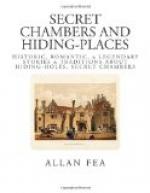From Horace Walpole, Mrs. Radcliffe, Scott, Victor Hugo, Dumas, Lytton, Ainsworth, Le Fanu, and Mrs. Henry Wood, down to the latest up-to-date novelists of to-day, the secret chamber (an ingenious necessity of the “good old times”) has afforded invaluable “property”—indeed, in many instances the whole vitality of a plot is, like its ingenious opening, hinged upon the masked wall, behind which lay concealed what hidden mysteries, what undreamed-of revelations! The thread of the story, like Fair Rosamond’s silken clue, leads up to and at length reveals the buried secret, and (unlike the above comparison in this instance) all ends happily!
Bulwer Lytton honestly confesses that the spirit of romance in his novels “was greatly due to their having been written at my ancestral home, Knebworth, Herts. How could I help writing romances,” he says, “after living amongst the secret panels and hiding-places of our dear old home? How often have I trembled with fear at the sound of my own footsteps when I ventured into the picture gallery! How fearfully have I glanced at the faces of my ancestors as I peered into the shadowy abysses of the ‘secret chamber.’ It was years before I could venture inside without my hair literally bristling with terror.”
What would Woodstock be without the mysterious picture, Peveril of the Peak without the sliding panel, the Castlewood of Esmond without Father Holt’s concealed apartments, Ninety-Three, Marguerite de Valois, The Tower of London, Guy Fawkes, and countless other novels of the same type, without the convenient contrivances of which the dramatis personae make such effectual use?




